外研版(2019)高中英语选择性必修第一册 Unit4 Meeting the muse Using Language 名师教学设计
文档属性
| 名称 | 外研版(2019)高中英语选择性必修第一册 Unit4 Meeting the muse Using Language 名师教学设计 | 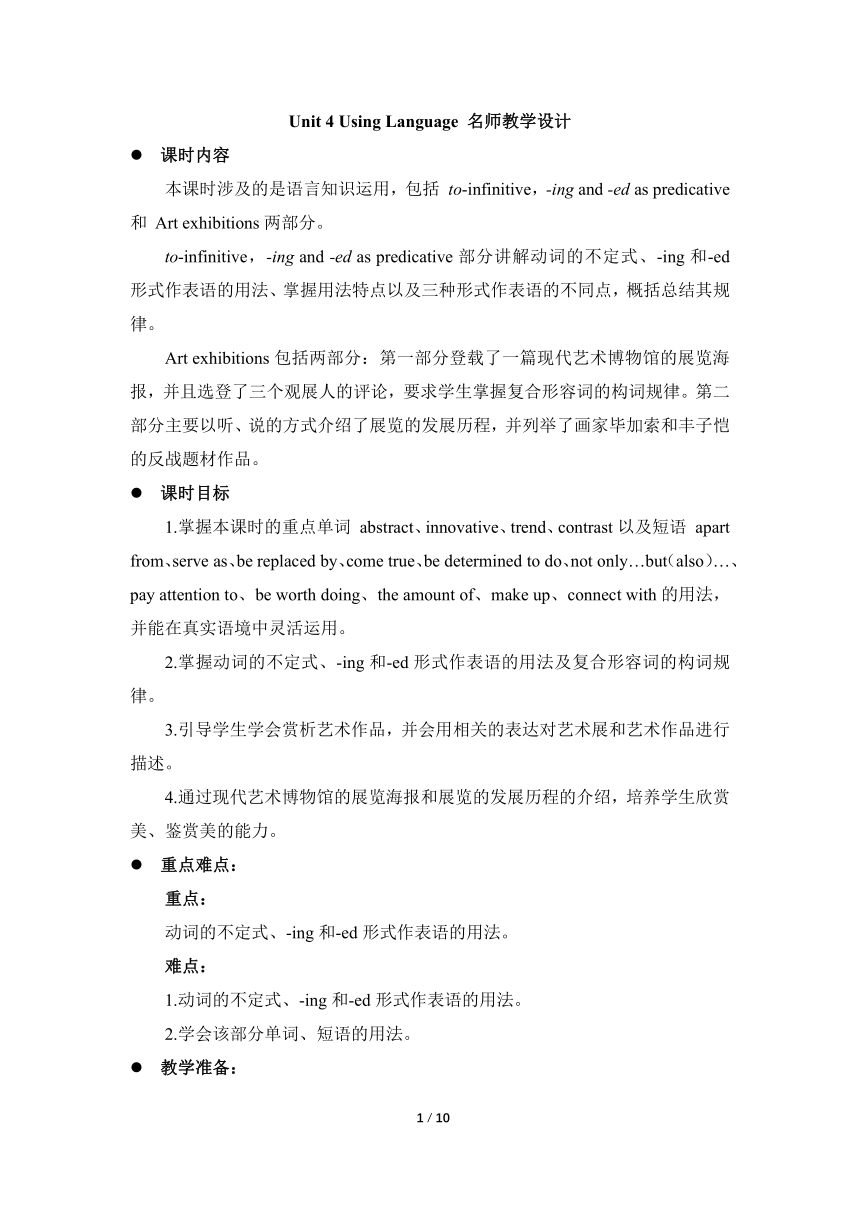 | |
| 格式 | docx | ||
| 文件大小 | 3.4MB | ||
| 资源类型 | 教案 | ||
| 版本资源 | 外研版(2019) | ||
| 科目 | 英语 | ||
| 更新时间 | 2023-03-02 17:08:59 | ||
图片预览

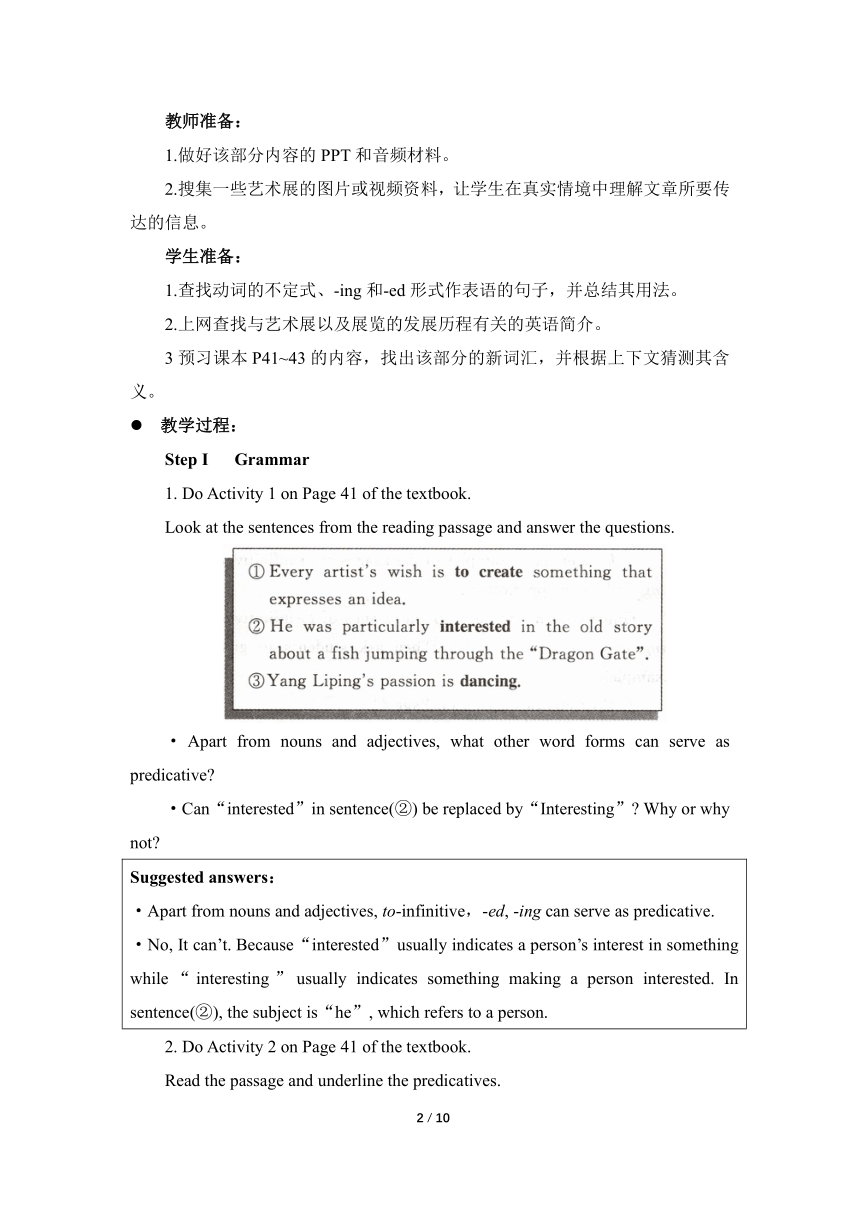
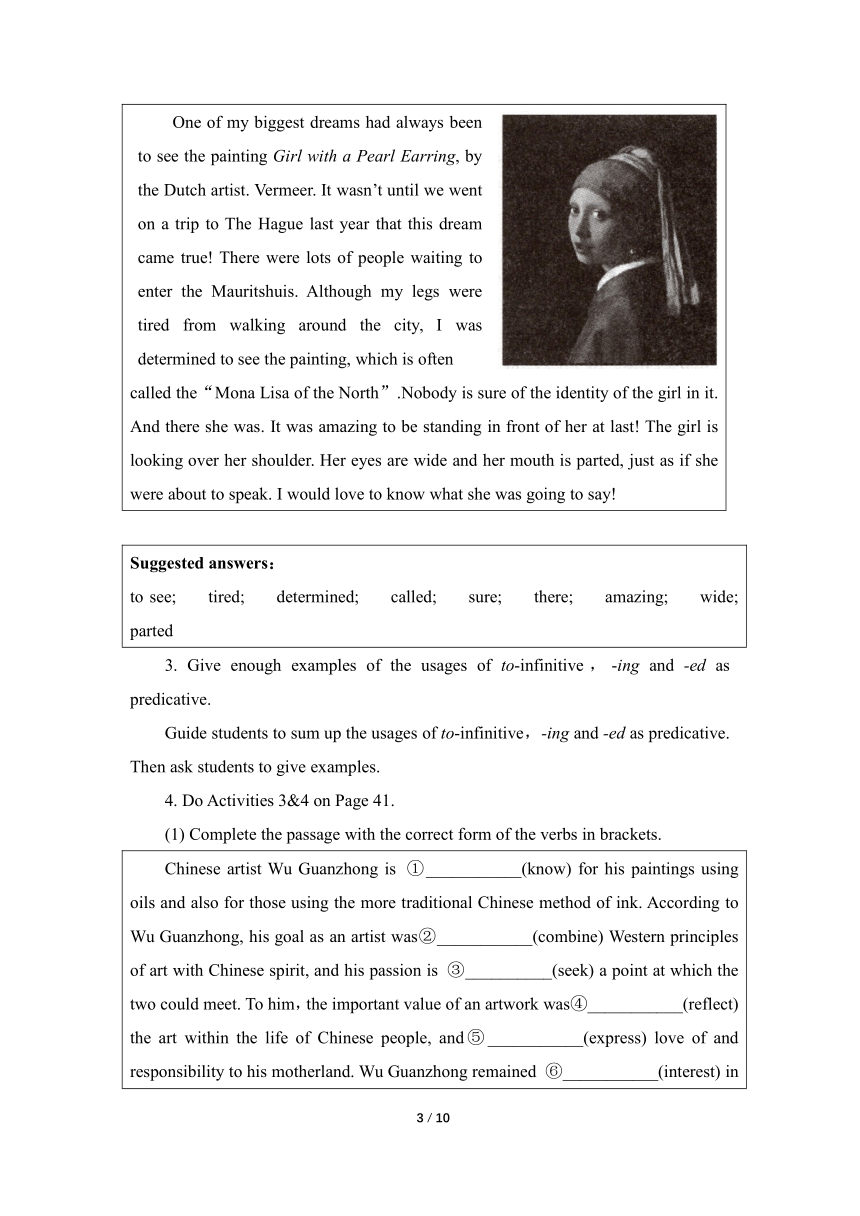
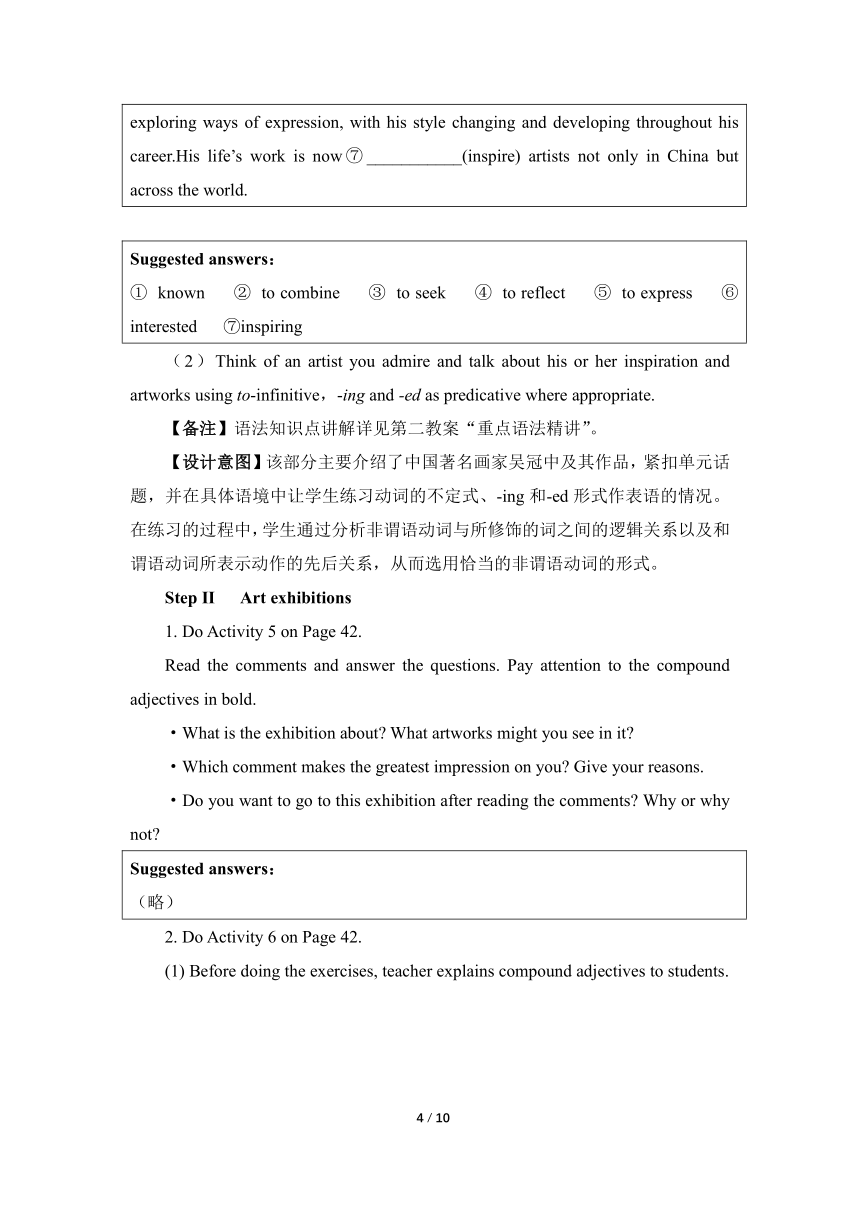
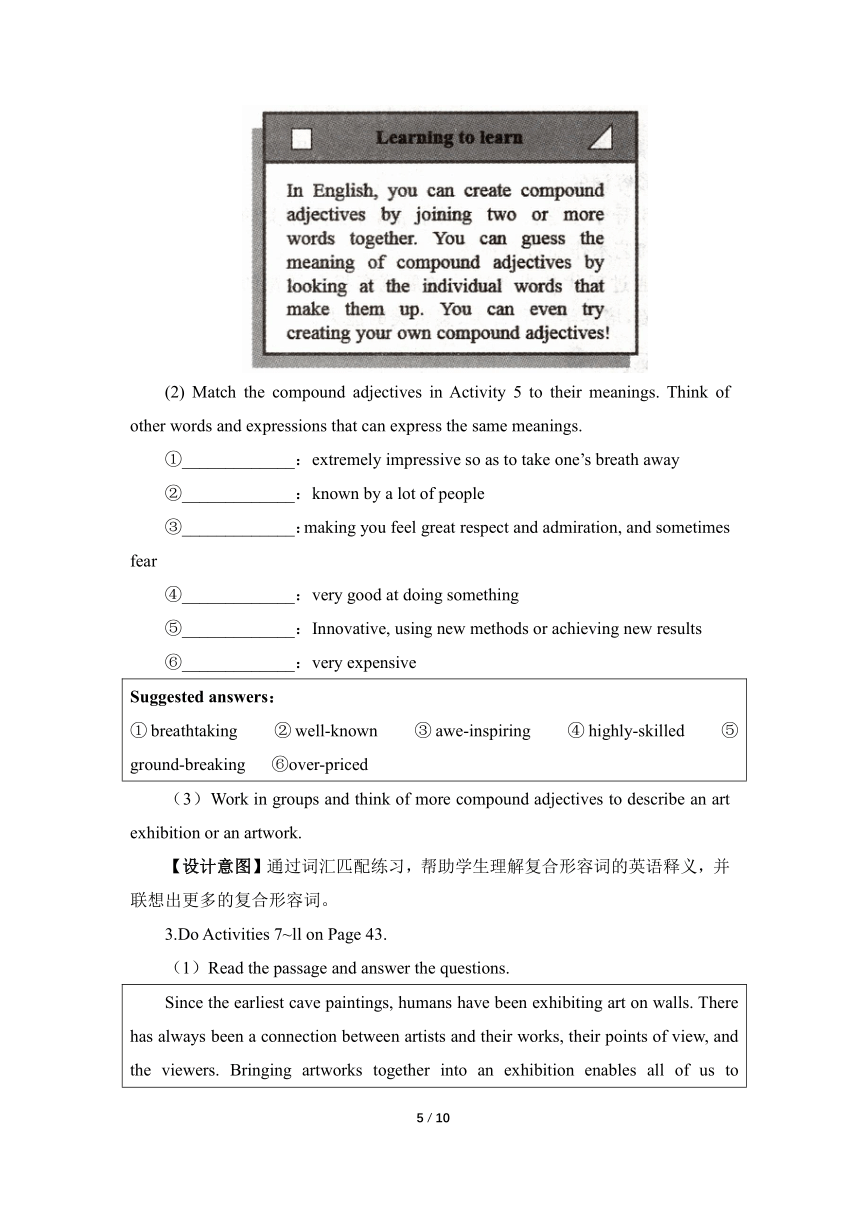
文档简介
Unit 4 Using Language 名师教学设计
课时内容
本课时涉及的是语言知识运用,包括 to-infinitive,-ing and -ed as predicative和 Art exhibitions两部分。
to-infinitive,-ing and -ed as predicative部分讲解动词的不定式、-ing和-ed形式作表语的用法、掌握用法特点以及三种形式作表语的不同点,概括总结其规律。
Art exhibitions包括两部分:第一部分登载了一篇现代艺术博物馆的展览海报,并且选登了三个观展人的评论,要求学生掌握复合形容词的构词规律。第二部分主要以听、说的方式介绍了展览的发展历程,并列举了画家毕加索和丰子恺的反战题材作品。
课时目标
1.掌握本课时的重点单词 abstract、innovative、trend、contrast以及短语 apart from、serve as、be replaced by、come true、be determined to do、not only…but(also)…、pay attention to、be worth doing、the amount of、make up、connect with的用法,并能在真实语境中灵活运用。
2.掌握动词的不定式、-ing和-ed形式作表语的用法及复合形容词的构词规律。
3.引导学生学会赏析艺术作品,并会用相关的表达对艺术展和艺术作品进行描述。
4.通过现代艺术博物馆的展览海报和展览的发展历程的介绍,培养学生欣赏美、鉴赏美的能力。
重点难点:
重点:
动词的不定式、-ing和-ed形式作表语的用法。
难点:
1.动词的不定式、-ing和-ed形式作表语的用法。
2.学会该部分单词、短语的用法。
教学准备:
教师准备:
1.做好该部分内容的PPT和音频材料。
2.搜集一些艺术展的图片或视频资料,让学生在真实情境中理解文章所要传达的信息。
学生准备:
1.查找动词的不定式、-ing和-ed形式作表语的句子,并总结其用法。
2.上网查找与艺术展以及展览的发展历程有关的英语简介。
3预习课本P41~43的内容,找出该部分的新词汇,并根据上下文猜测其含义。
教学过程:
Step Ⅰ Grammar
1. Do Activity 1 on Page 41 of the textbook.
Look at the sentences from the reading passage and answer the questions.
·Apart from nouns and adjectives, what other word forms can serve as predicative
·Can“interested”in sentence(②) be replaced by“Interesting” Why or why not
Suggested answers: ·Apart from nouns and adjectives, to-infinitive,-ed, -ing can serve as predicative. ·No, It can’t. Because“interested”usually indicates a person’s interest in something while“interesting”usually indicates something making a person interested. In sentence(②), the subject is“he”, which refers to a person.
2. Do Activity 2 on Page 41 of the textbook.
Read the passage and underline the predicatives.
One of my biggest dreams had always been to see the painting Girl with a Pearl Earring, by the Dutch artist. Vermeer. It wasn’t until we went on a trip to The Hague last year that this dream came true! There were lots of people waiting to enter the Mauritshuis. Although my legs were tired from walking around the city, I was determined to see the painting, which is often
called the“Mona Lisa of the North”.Nobody is sure of the identity of the girl in it. And there she was. It was amazing to be standing in front of her at last! The girl is looking over her shoulder. Her eyes are wide and her mouth is parted, just as if she were about to speak. I would love to know what she was going to say!
Suggested answers: to see; tired; determined; called; sure; there; amazing; wide; parted
3. Give enough examples of the usages of to-infinitive,-ing and -ed as predicative.
Guide students to sum up the usages of to-infinitive,-ing and -ed as predicative. Then ask students to give examples.
4. Do Activities 3&4 on Page 41.
(1) Complete the passage with the correct form of the verbs in brackets.
Chinese artist Wu Guanzhong is ①___________(know) for his paintings using oils and also for those using the more traditional Chinese method of ink. According to Wu Guanzhong, his goal as an artist was②___________(combine) Western principles of art with Chinese spirit, and his passion is ③__________(seek) a point at which the two could meet. To him,the important value of an artwork was④___________(reflect) the art within the life of Chinese people, and⑤___________(express) love of and responsibility to his motherland. Wu Guanzhong remained ⑥___________(interest) in exploring ways of expression, with his style changing and developing throughout his career.His life’s work is now⑦___________(inspire) artists not only in China but across the world.
Suggested answers: ① known ② to combine ③ to seek ④ to reflect ⑤ to express ⑥ interested ⑦inspiring
(2)Think of an artist you admire and talk about his or her inspiration and artworks using to-infinitive,-ing and -ed as predicative where appropriate.
【备注】语法知识点讲解详见第二教案“重点语法精讲”。
【设计意图】该部分主要介绍了中国著名画家吴冠中及其作品,紧扣单元话题,并在具体语境中让学生练习动词的不定式、-ing和-ed形式作表语的情况。在练习的过程中,学生通过分析非谓语动词与所修饰的词之间的逻辑关系以及和谓语动词所表示动作的先后关系,从而选用恰当的非谓语动词的形式。
Step Ⅱ Art exhibitions
1. Do Activity 5 on Page 42.
Read the comments and answer the questions. Pay attention to the compound adjectives in bold.
·What is the exhibition about What artworks might you see in it
·Which comment makes the greatest impression on you Give your reasons.
·Do you want to go to this exhibition after reading the comments Why or why not
Suggested answers: (略)
2. Do Activity 6 on Page 42.
(1) Before doing the exercises, teacher explains compound adjectives to students.
(2) Match the compound adjectives in Activity 5 to their meanings. Think of other words and expressions that can express the same meanings.
①_____________:extremely impressive so as to take one’s breath away
②_____________:known by a lot of people
③_____________:making you feel great respect and admiration, and sometimes fear
④_____________:very good at doing something
⑤_____________:Innovative, using new methods or achieving new results
⑥_____________:very expensive
Suggested answers: ①breathtaking ②well-known ③awe-inspiring ④highly-skilled ⑤ground-breaking ⑥over-priced
(3)Work in groups and think of more compound adjectives to describe an art exhibition or an artwork.
【设计意图】通过词汇匹配练习,帮助学生理解复合形容词的英语释义,并联想出更多的复合形容词。
3.Do Activities 7~ll on Page 43.
(1)Read the passage and answer the questions.
Since the earliest cave paintings, humans have been exhibiting art on walls. There has always been a connection between artists and their works, their points of view, and the viewers. Bringing artworks together into an exhibition enables all of us to experience the works, to respond to, to enjoy and to connect with them . Art exhibitions can have many themes, such as a historical period, a location or a trend. Of them all, one everlasting source of inspiration is war and peace.Countless artists have been protesting wars and promoting peace via their works, including Spanish artist Pablo Picasso and Chinese artist Feng zikai, to name just a couple.
·What else do you know about Pablo Picasso and Feng Zikai
·What other artists are famous for representing war and peace What are their best-known artworks
Suggested answers: (略)
(2) Listen to the audio guide and find out the main message of each artwork.
Guernica
The Battlefield in spring
(3) Listen again and complete the notes.
Guernica, by Pablo Picasso ·Painted after①______________of Guernica ·Size:②______________ ·Images:a bull, a horse, a light bulb and a(n)③______________lying on the ground ·Using only three colours for④______________
The Battle field in spring, by Feng Zikai ·Painted⑤______________Japanese aggression against China ·Images:sandbags, an army cap, a wire fence and⑥______________ ·Contrast achieved with⑦______________ ·Showing Feng Zikai’s⑧______________
Suggested answers: ①the attack on the town ②3.5 metres in height and almost 8 metres in width ③dead or wounded man ④a more powerful effect ⑤in protest of ⑥some grass leaves ⑦the lifeless objects and the grass leaves ⑧encouragement to the Chinese people as well as his hope for peace
(4) Complete the table with the expressions from the audio guide.
…by the well-known… It measures… In the centre of the painting, we can see… Through…, I can see/feel… In my opinion, this makes… …create a strong contrast. I personally think… It is widely believed…
About an artwork
Basic information What you see How you feel
Suggested answers: Basic information: …by the well-known… It measures… It is widely believed… What you see: In the centre of the painting, we can see… Through…, I can see... How you feel: Through…, I can feel… In my opinion, this makes… …create a strong contrast. I personally think…
(5)Choose an art exhibition,or an artwork from an exhibition you like,and write about it using the words and expressions in this section.
(6)Work in pairs.
Make improvements to each other’s writings and share them with the class.
【设计意图】听力练习设置了两个相应的练习题,第一次听录音,回答有关毕加索和丰子恺信息的问题;第二次听录音,难度有所增加,要求在听的同时填写空缺内容,写出关键信息。听完录音后,先处理前两个练习题,在语言输入的基础上进行语言输出,让学生自己创设语境作对话。
Step Ⅲ Exercises
Fill in blanks with the proper forms of the words in brackets.
① She was deeply__________(move) by the sad story, so she read it until into the night. ② The film that he recommended to us is very__________ (interest). ③ She was__________ (satisfy) with her daughter’s exam results. ④ The difference between these two words are__________ (strike). ⑤ What Joe wants to do seems__________ (tell) you something. ⑥ Mary doesn’t seem__________(like) the idea.
Suggested answers: ① moved ② interesting ③ satisfied ④ striking ⑤ to tell ⑥ to like
【设计意图】通过该练习的设置,学生学会分析非谓语动词与所修饰的名词之间的逻辑关系,进而掌握其作表语的用法。
Step IV Summing up
总结动词的不定式、-ing和-ed形式作表语的用法,注意该部分新学词汇的运用。
Step V Homework
1. Give students some examples to fill in the blanks with to-infinitive, -ing and -ed as predicative.
2. Master the usages of the new vocabulary.
板书设计:
Unit 4 Meeting the muse Period II Using language I Grammar 1. Do Activity 1 on Page 41 of the textbook. 2. Do Activity 2 on Page 41 of the textbook. 3. Give enough examples of the usages of to-infinitive,-ing and -ed as predicative. 4. Do Activities 3&4 on Page 41. Ⅱ. Art exhibitions 1. Do activity 5 on Page 42. 2. Do Activity 6 on Page 42. 3. Do Activities 7~11 on Page 43. (1) Read the passage and answer the questions. (2) Listen to the audio guide and find out the main message of each artwork. (3) Listen again and complete the notes. (4) Complete the table with the expressions from the audio guide. (5) Choose an art exhibition, or an artwork from an exhibition you like, and write about it using the words and expressions in this section. (6) Work in pairs. Ⅲ. Exercises IV. Summing up V. Homework
1 / 10
课时内容
本课时涉及的是语言知识运用,包括 to-infinitive,-ing and -ed as predicative和 Art exhibitions两部分。
to-infinitive,-ing and -ed as predicative部分讲解动词的不定式、-ing和-ed形式作表语的用法、掌握用法特点以及三种形式作表语的不同点,概括总结其规律。
Art exhibitions包括两部分:第一部分登载了一篇现代艺术博物馆的展览海报,并且选登了三个观展人的评论,要求学生掌握复合形容词的构词规律。第二部分主要以听、说的方式介绍了展览的发展历程,并列举了画家毕加索和丰子恺的反战题材作品。
课时目标
1.掌握本课时的重点单词 abstract、innovative、trend、contrast以及短语 apart from、serve as、be replaced by、come true、be determined to do、not only…but(also)…、pay attention to、be worth doing、the amount of、make up、connect with的用法,并能在真实语境中灵活运用。
2.掌握动词的不定式、-ing和-ed形式作表语的用法及复合形容词的构词规律。
3.引导学生学会赏析艺术作品,并会用相关的表达对艺术展和艺术作品进行描述。
4.通过现代艺术博物馆的展览海报和展览的发展历程的介绍,培养学生欣赏美、鉴赏美的能力。
重点难点:
重点:
动词的不定式、-ing和-ed形式作表语的用法。
难点:
1.动词的不定式、-ing和-ed形式作表语的用法。
2.学会该部分单词、短语的用法。
教学准备:
教师准备:
1.做好该部分内容的PPT和音频材料。
2.搜集一些艺术展的图片或视频资料,让学生在真实情境中理解文章所要传达的信息。
学生准备:
1.查找动词的不定式、-ing和-ed形式作表语的句子,并总结其用法。
2.上网查找与艺术展以及展览的发展历程有关的英语简介。
3预习课本P41~43的内容,找出该部分的新词汇,并根据上下文猜测其含义。
教学过程:
Step Ⅰ Grammar
1. Do Activity 1 on Page 41 of the textbook.
Look at the sentences from the reading passage and answer the questions.
·Apart from nouns and adjectives, what other word forms can serve as predicative
·Can“interested”in sentence(②) be replaced by“Interesting” Why or why not
Suggested answers: ·Apart from nouns and adjectives, to-infinitive,-ed, -ing can serve as predicative. ·No, It can’t. Because“interested”usually indicates a person’s interest in something while“interesting”usually indicates something making a person interested. In sentence(②), the subject is“he”, which refers to a person.
2. Do Activity 2 on Page 41 of the textbook.
Read the passage and underline the predicatives.
One of my biggest dreams had always been to see the painting Girl with a Pearl Earring, by the Dutch artist. Vermeer. It wasn’t until we went on a trip to The Hague last year that this dream came true! There were lots of people waiting to enter the Mauritshuis. Although my legs were tired from walking around the city, I was determined to see the painting, which is often
called the“Mona Lisa of the North”.Nobody is sure of the identity of the girl in it. And there she was. It was amazing to be standing in front of her at last! The girl is looking over her shoulder. Her eyes are wide and her mouth is parted, just as if she were about to speak. I would love to know what she was going to say!
Suggested answers: to see; tired; determined; called; sure; there; amazing; wide; parted
3. Give enough examples of the usages of to-infinitive,-ing and -ed as predicative.
Guide students to sum up the usages of to-infinitive,-ing and -ed as predicative. Then ask students to give examples.
4. Do Activities 3&4 on Page 41.
(1) Complete the passage with the correct form of the verbs in brackets.
Chinese artist Wu Guanzhong is ①___________(know) for his paintings using oils and also for those using the more traditional Chinese method of ink. According to Wu Guanzhong, his goal as an artist was②___________(combine) Western principles of art with Chinese spirit, and his passion is ③__________(seek) a point at which the two could meet. To him,the important value of an artwork was④___________(reflect) the art within the life of Chinese people, and⑤___________(express) love of and responsibility to his motherland. Wu Guanzhong remained ⑥___________(interest) in exploring ways of expression, with his style changing and developing throughout his career.His life’s work is now⑦___________(inspire) artists not only in China but across the world.
Suggested answers: ① known ② to combine ③ to seek ④ to reflect ⑤ to express ⑥ interested ⑦inspiring
(2)Think of an artist you admire and talk about his or her inspiration and artworks using to-infinitive,-ing and -ed as predicative where appropriate.
【备注】语法知识点讲解详见第二教案“重点语法精讲”。
【设计意图】该部分主要介绍了中国著名画家吴冠中及其作品,紧扣单元话题,并在具体语境中让学生练习动词的不定式、-ing和-ed形式作表语的情况。在练习的过程中,学生通过分析非谓语动词与所修饰的词之间的逻辑关系以及和谓语动词所表示动作的先后关系,从而选用恰当的非谓语动词的形式。
Step Ⅱ Art exhibitions
1. Do Activity 5 on Page 42.
Read the comments and answer the questions. Pay attention to the compound adjectives in bold.
·What is the exhibition about What artworks might you see in it
·Which comment makes the greatest impression on you Give your reasons.
·Do you want to go to this exhibition after reading the comments Why or why not
Suggested answers: (略)
2. Do Activity 6 on Page 42.
(1) Before doing the exercises, teacher explains compound adjectives to students.
(2) Match the compound adjectives in Activity 5 to their meanings. Think of other words and expressions that can express the same meanings.
①_____________:extremely impressive so as to take one’s breath away
②_____________:known by a lot of people
③_____________:making you feel great respect and admiration, and sometimes fear
④_____________:very good at doing something
⑤_____________:Innovative, using new methods or achieving new results
⑥_____________:very expensive
Suggested answers: ①breathtaking ②well-known ③awe-inspiring ④highly-skilled ⑤ground-breaking ⑥over-priced
(3)Work in groups and think of more compound adjectives to describe an art exhibition or an artwork.
【设计意图】通过词汇匹配练习,帮助学生理解复合形容词的英语释义,并联想出更多的复合形容词。
3.Do Activities 7~ll on Page 43.
(1)Read the passage and answer the questions.
Since the earliest cave paintings, humans have been exhibiting art on walls. There has always been a connection between artists and their works, their points of view, and the viewers. Bringing artworks together into an exhibition enables all of us to experience the works, to respond to, to enjoy and to connect with them . Art exhibitions can have many themes, such as a historical period, a location or a trend. Of them all, one everlasting source of inspiration is war and peace.Countless artists have been protesting wars and promoting peace via their works, including Spanish artist Pablo Picasso and Chinese artist Feng zikai, to name just a couple.
·What else do you know about Pablo Picasso and Feng Zikai
·What other artists are famous for representing war and peace What are their best-known artworks
Suggested answers: (略)
(2) Listen to the audio guide and find out the main message of each artwork.
Guernica
The Battlefield in spring
(3) Listen again and complete the notes.
Guernica, by Pablo Picasso ·Painted after①______________of Guernica ·Size:②______________ ·Images:a bull, a horse, a light bulb and a(n)③______________lying on the ground ·Using only three colours for④______________
The Battle field in spring, by Feng Zikai ·Painted⑤______________Japanese aggression against China ·Images:sandbags, an army cap, a wire fence and⑥______________ ·Contrast achieved with⑦______________ ·Showing Feng Zikai’s⑧______________
Suggested answers: ①the attack on the town ②3.5 metres in height and almost 8 metres in width ③dead or wounded man ④a more powerful effect ⑤in protest of ⑥some grass leaves ⑦the lifeless objects and the grass leaves ⑧encouragement to the Chinese people as well as his hope for peace
(4) Complete the table with the expressions from the audio guide.
…by the well-known… It measures… In the centre of the painting, we can see… Through…, I can see/feel… In my opinion, this makes… …create a strong contrast. I personally think… It is widely believed…
About an artwork
Basic information What you see How you feel
Suggested answers: Basic information: …by the well-known… It measures… It is widely believed… What you see: In the centre of the painting, we can see… Through…, I can see... How you feel: Through…, I can feel… In my opinion, this makes… …create a strong contrast. I personally think…
(5)Choose an art exhibition,or an artwork from an exhibition you like,and write about it using the words and expressions in this section.
(6)Work in pairs.
Make improvements to each other’s writings and share them with the class.
【设计意图】听力练习设置了两个相应的练习题,第一次听录音,回答有关毕加索和丰子恺信息的问题;第二次听录音,难度有所增加,要求在听的同时填写空缺内容,写出关键信息。听完录音后,先处理前两个练习题,在语言输入的基础上进行语言输出,让学生自己创设语境作对话。
Step Ⅲ Exercises
Fill in blanks with the proper forms of the words in brackets.
① She was deeply__________(move) by the sad story, so she read it until into the night. ② The film that he recommended to us is very__________ (interest). ③ She was__________ (satisfy) with her daughter’s exam results. ④ The difference between these two words are__________ (strike). ⑤ What Joe wants to do seems__________ (tell) you something. ⑥ Mary doesn’t seem__________(like) the idea.
Suggested answers: ① moved ② interesting ③ satisfied ④ striking ⑤ to tell ⑥ to like
【设计意图】通过该练习的设置,学生学会分析非谓语动词与所修饰的名词之间的逻辑关系,进而掌握其作表语的用法。
Step IV Summing up
总结动词的不定式、-ing和-ed形式作表语的用法,注意该部分新学词汇的运用。
Step V Homework
1. Give students some examples to fill in the blanks with to-infinitive, -ing and -ed as predicative.
2. Master the usages of the new vocabulary.
板书设计:
Unit 4 Meeting the muse Period II Using language I Grammar 1. Do Activity 1 on Page 41 of the textbook. 2. Do Activity 2 on Page 41 of the textbook. 3. Give enough examples of the usages of to-infinitive,-ing and -ed as predicative. 4. Do Activities 3&4 on Page 41. Ⅱ. Art exhibitions 1. Do activity 5 on Page 42. 2. Do Activity 6 on Page 42. 3. Do Activities 7~11 on Page 43. (1) Read the passage and answer the questions. (2) Listen to the audio guide and find out the main message of each artwork. (3) Listen again and complete the notes. (4) Complete the table with the expressions from the audio guide. (5) Choose an art exhibition, or an artwork from an exhibition you like, and write about it using the words and expressions in this section. (6) Work in pairs. Ⅲ. Exercises IV. Summing up V. Homework
1 / 10
